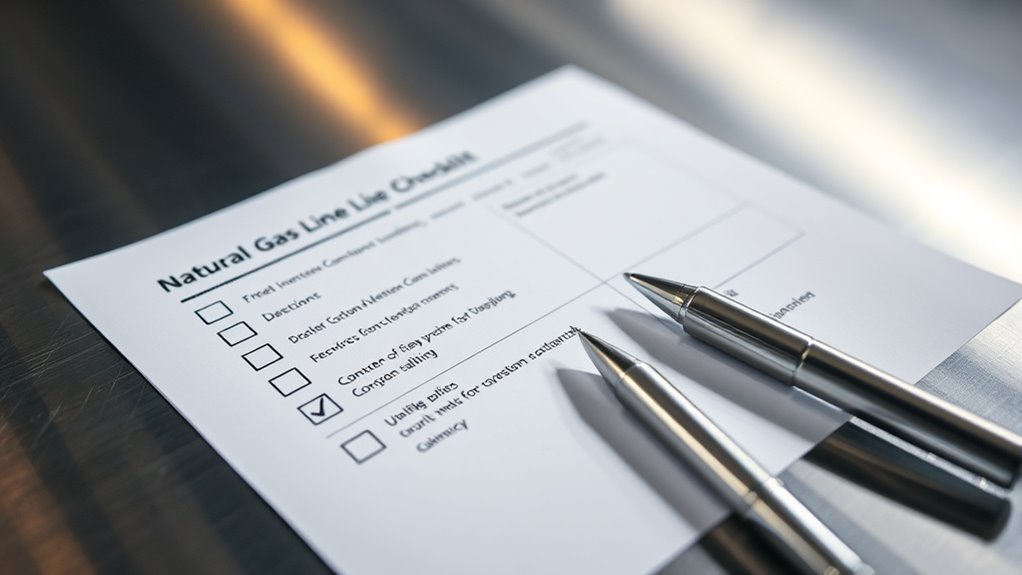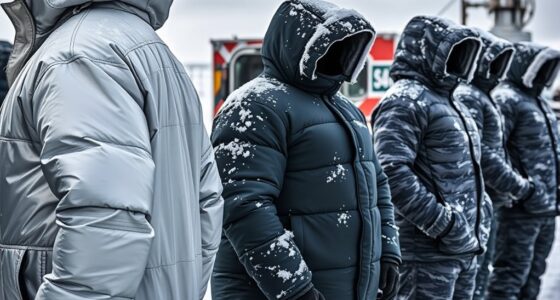In just 15 minutes, you can quickly verify your natural gas line sizing by calculating the total BTU load of your appliances, ensuring the pipe diameter matches the demand, and confirming compliance with local codes. Plan your pipeline route carefully, use quality materials, and tighten all connections securely. Run a pressure test to check for leaks and document everything. Keep these steps in mind, and you’ll better understand how to guarantee a safe, efficient gas line—more tips follow.
Key Takeaways
- Calculate total BTU load of all appliances to determine required pipe capacity.
- Select pipe diameter based on BTU demand, pipe length, and flow rate using sizing charts or software.
- Verify compliance with local codes, maximum pressure limits, and material standards before installation.
- Plan the pipeline route for accessibility, use approved materials, and tighten all fittings securely.
- Conduct a pressure test for leaks, document all calculations and tests, and ensure safety standards are met.
Quick Guide to Gas Line Sizing

When installing a natural gas line, proper sizing is essential to guarantee safety, efficiency, and reliable gas flow. You need to verify that the pipeline can handle the expected load without risking overpressure or insufficient supply. Starting with correct sizing helps you stay ahead of potential issues and keeps your project compliant with local regulations. Pipeline safety depends heavily on adhering to proper sizing standards, which prevent leaks, reduce the risk of explosions, and ensure safe operation over time. Keeping your installation within code compliance isn’t just about following rules; it’s about protecting lives, property, and your reputation.
Proper gas line sizing ensures safety, efficiency, and code compliance for reliable operation and long-term peace of mind.
To get it right quickly, you should begin by calculating the total BTU demand of all appliances and equipment connected to the line. This step makes sure your pipeline can deliver enough gas without pressure drops. Once you know the total BTUs, you can determine the appropriate pipe diameter using standard sizing charts or software designed for gas line calculations. These tools account for pipe length, number of fittings, and expected flow rates, so you can make precise decisions in minutes. Avoid under-sizing, which can cause inadequate flow and pressure issues, or over-sizing, which may lead to unnecessary costs and complexity. The goal is to find the sweet spot where the pipe is just right for your specific needs.
Additionally, understanding dog names can play a role in choosing a name that reflects your preferences or the personality of your pet, adding a personal touch to your selection process.
Next, check the local building codes and regulations to confirm your chosen pipe size complies with safety standards. Code compliance isn’t optional; it’s a legal requirement that ensures your installation has been reviewed and approved for safety and performance. Many codes specify maximum allowable pressure, material types, and installation practices, so referencing these early prevents costly revisions later. Staying within code guidelines also minimizes liability and makes inspections smoother.
During your quick checklist, don’t forget to verify the pipeline’s route and accessibility. Proper planning reduces the risk of damage or accidental interference later on. Use high-quality, approved materials, and ensure all fittings and joints meet safety standards. Tighten connections properly, as leaks can be deadly and compromise pipeline safety. Conduct pressure tests after installation to confirm there are no leaks and that the line can sustain the operating pressure safely. Document everything, including calculations, material specs, and test results, to provide proof of compliance if needed.
In just 15 minutes, you can perform a rapid, effective review of your gas line sizing, reinforcing safety, efficiency, and code compliance. This proactive approach helps you avoid costly mistakes, keeps your project on track, and ultimately ensures a safe and reliable gas supply for years to come.
Frequently Asked Questions
Can I Use This Checklist for Outdoor Gas Line Installations?
Yes, you can use this checklist for outdoor installation, but you should modify it to account for outdoor-specific safety considerations. Outdoor installations face different weather, soil, and environmental factors that impact gas line sizing and safety. Make sure to include checks for proper insulation, corrosion protection, and secure anchoring. Always follow local codes and regulations to ensure safety and compliance during outdoor gas line installation.
What Safety Precautions Should I Follow During Sizing?
You should always verify safety protocols before sizing gas lines, especially outdoors. Investigating whether current standards align with outdoor conditions reveals that proper safety measures are essential. Use accurate measurement tools like pressure gauges and flow meters to guarantee precise readings, minimizing risks. Always wear personal protective equipment, work in well-ventilated areas, and follow local codes. These precautions help prevent accidents, ensuring a safe and efficient sizing process.
Is Specialized Equipment Required for Quick Measurements?
No, specialized equipment isn’t strictly necessary for quick measurements. You can use standard measuring tools like pressure gauges and flow meters, which are easy to operate. Just make certain these tools are properly calibrated before use—following calibration procedures guarantees accurate readings. This way, you get reliable measurements quickly, helping you efficiently size the natural gas line without the need for complex or expensive equipment.
How Do Local Codes Affect the Sizing Process?
Local codes and regional standards substantially impact your natural gas line sizing process. You need to verify code compliance by reviewing specific regional regulations, which may dictate pipe sizes, pressure limits, and safety requirements. Failing to follow these standards could lead to penalties or safety issues. Always check with local authorities before finalizing your design, and incorporate the regional standards into your calculations for a compliant, efficient gas line system.
Can This Checklist Be Used for Commercial Gas Systems?
Yes, you can use this checklist for commercial gas systems, but make certain it aligns with commercial regulations and system compatibility. Commercial systems often have different requirements, so verify that the checklist covers all necessary standards. Always adapt the process based on specific industry rules and system specifications. Doing so helps you maintain safety, efficiency, and compliance when sizing natural gas lines in commercial settings.
Conclusion
With this quick, clear checklist, you can confidently determine the correct gas line size in just 15 minutes. Follow these focused steps to avoid errors, guarantee safety, and streamline your process. Remember, precise planning prevents problems, so stay sharp, stay swift, and succeed with this simple sizing solution. Speed, safety, and success are just a checklist away—making your gas line project smooth, simple, and stress-free!








